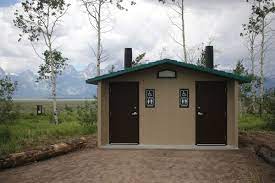Campgrounds offer a haven for outdoor enthusiasts, providing an escape into the beauty of nature. Amidst the trees, trails, and starlit nights, one often encounters a humble yet essential structure—the campground vault toilet. This article delves into the significance of these facilities, their unique design, and the environmental advantages they bring to outdoor spaces.
The Purpose of Campground Vault Toilets:
Campground vault toilets serve a fundamental purpose in providing sanitary facilities for campers, hikers, and nature lovers in remote or rustic settings where traditional plumbing is impractical. These structures are strategically placed to offer convenience while minimizing the environmental impact on the surrounding wilderness.
Design and Construction:
Vault toilets are characterized by a simple and efficient design. The key component is the vault, typically made of concrete or fiberglass, situated beneath the toilet seat. This vault acts as a temporary storage unit for waste, mitigating the need for complex sewage systems in areas. Where such infrastructure is neither practical nor environmentally sustainable.
Ventilation systems are integrated into the design to control odors and promote airflow within the structure. Additionally, the inclusion of toilet paper dispensers, hand sanitizer stations, and ADA-compliant features ensures that these facilities cater to a diverse range of users while maintaining hygiene standards.
Environmental Benefits:
- Water Conservation: One of the primary environmental benefits of campground vault toilets is their minimal water usage. Unlike traditional flush toilets, which rely on significant amounts of water for each use, vault toilets are waterless or use very little water for handwashing. This conservation aspect is crucial in preserving water resources, especially in areas with limited access.
- Waste Management: The vault in these toilets acts as a containment unit for waste, allowing for controlled decomposition. The addition of bulking agents, such as sawdust or peat moss, aids in the natural breakdown of organic matter. This process reduces the volume of waste, minimizing the impact on landfills and promoting responsible waste management practices.
- Off-Grid Suitability: Campground vault toilets are designed for off-grid locations where connecting to centralized sewage systems is impractical. Whether in national parks, wilderness areas, or remote camping sites, these toilets provide a sustainable and sanitary solution. Ensuring that human waste does not harm the delicate ecosystems of natural surroundings.
- Low Environmental Footprint: The environmental footprint of campground vault toilets is significantly lower than that of traditional sewage systems. By avoiding the need for extensive infrastructure and large-scale water consumption, these facilities contribute to the preservation of natural landscapes and ecosystems.
Community and Visitor Considerations:
Campground vault toilets play a crucial role in enhancing the overall camping experience. Ensuring that visitors can immerse themselves in nature without sacrificing essential amenities. Proper signage, education on usage, and routine maintenance are essential aspects of ensuring that these facilities remain functional, hygienic, and environmentally responsible.
Conclusion:
Campground vault toilets are a testament to thoughtful and sustainable design, providing a necessary service without compromising the integrity of natural environments. Their water-efficient and eco-friendly features make them an essential part of outdoor recreational spaces. Catering to the needs of campers while preserving the beauty and biodiversity of the surrounding wilderness. As we continue to prioritize environmentally conscious practices. The importance of campground vault toilets becomes increasingly evident in fostering a harmonious coexistence between outdoor enthusiasts and the pristine landscapes they seek to explore.

